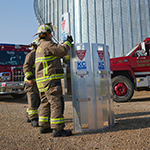Identifying grain bin hazards
Learn about grain bin hazards related to augers, bin collapses, PTOs, fires and explosions, toxic atmospheres and more.
Grain bin entrapment is one of the biggest hazards on today’s grain farms. It takes less than five seconds to become helplessly trapped in flowing grain and less than 30 seconds to become fully engulfed and overwhelmed.
Grain bin hazards aren’t limited to entrapment or engulfment. Grain handling equipment like augers, power take-off systems and hazards like collapsing bins, fires, toxic fumes, electrical components and ladders can pose serious dangers to health and human safety.
To help ensure safety, it’s important to identify and understand all grain bin hazards, especially when it comes to three key areas: grain condition, atmospheric conditions and equipment and structures.
Grain conditions
- Flowing grain. Entrapment is the most often identified hazard and cause of injury when working with flowing grain. Like quicksand, flowing grain will pull a 165-pound man down to waist level in seconds and bury him in less than a minute. Most experts agree that once you have grain above your knees, there’s almost no chance of escape without assistance. Learn how you can nominate your local fire department to win grain bin rescue training and a rescue tube.
- Bridged grain. A grain bridge is a hardened, crust-like mass of grain that contains a cavity or air pocket underneath. Bridged grain is often caused by poorly conditioned or frozen grain. Never enter the bin or try to move across bridged grain to prevent cave-ins that can be deadly. Instead, break up the bridged grain using a long pole from outside the bin. Here are more bridged grain safety measures.
- Crusted grain. Like bridged grain, crusted grain is often caused by high moisture content. Instead of forming a grain bridge, the grain sticks to the bin walls. If a worker enters the bin to break the grain free, the grain can “avalanche,” completely engulfing and suffocating the worker. Again, using a long pole from outside the bin is the safest way to break up the grain.
Atmospheric conditions
- Toxic atmospheres. Grain dust from damaged or deteriorated grain can also pose a range of health hazards. Gases released by this kind of grain can reduce the oxygen in the air. Workers in these bins may experience a range of symptoms from skin rashes to major respiratory problems. Reduce these risks by introducing ventilation when and where needed and wearing appropriate protective equipment. Learn more about the hidden danger of toxic gases.
- Fires and explosions. In some conditions, grain dust inside a bin can ignite and explode. This can result in catastrophic damage and huge financial and human loss. Prevent these explosions by following a comprehensive dust and ignition control program. This may include the use of an oil suppression system. Learn more about the leading causes of grain bin fires and explosions and preventative measures you can take.
Equipment and structures
- Reclaim augers. A grain auger found in the bin floor is used to unload or empty grain. When left uncovered, a worker’s foot can easily become entangled in the auger’s rotating screw, risking amputation. Some reclaim augers use multiple sumps that must be emptied in sequence to prevent a bin floor collapse. Bins should always be emptied using only the main sump until grain is lowered to a level where it can no longer flow to the main sump by gravity. At that point, use the auxiliary sumps starting with the one closest to the center working to the outside one sump at a time. Using only an auxiliary sump to empty a full bin can result in uneven loading that can cause a bin collapse that will trap, crush or engulf any workers inside. Learn more about preventing grain bin collapses.
- Sweep augers. A Sweep auger rotates around a bin’s discharge opening to move grain toward the bin floor outlet. A portion of the auger’s screw assembly is unguarded by design and exposes workers to dangerous moving parts. Don't ever work in a bin while a sweep auger is running, except in situations outlined by the Occupational Health and Safety Administration (OSHA). Help workers steer clear of sweep augers and other mechanical devises inside grain bins.
- Unguarded-collection augers. Some automated grain bin drying systems use unguarded-collection augers at the bottom of the bin. Never enter these bins while the drying system is in operation because the collection augers can’t be seen under the grain.
- Fill augers A fill auger is powered by PTO, permanent or portable, and used to fill a bin. Without guards or safety shields in place, a PTO shaft can easily catch loose clothing or any other loose object and can wrap a person around it in less than one second.
- Stirring augers. A stirring auger is used in a drying bin to turn over grain and shorten drying time. A stirring auger is completely unguarded and can easily catch loose clothing and entangle a worker. Never enter a bin when stirring augers are running.
- Electrical components. Farmers and grain managers sometimes update older bins to increase storage capacity. If those bins have not been used for a while, damaged electrical wiring can create electrocution and fire risks. A certified electrician should thoroughly inspect all bin electrical systems before it is used. This will help reduce worker safety and health risks.
- Ladder falls can also cause serious injury. As with all ladders, keep three points of contact to help prevent falls when going up or down bin ladders. This means always maintaining contact with the ladder with two hands and one foot – or one hand and two feet – at all times. See this Safe Ladder Use Guide to help choose the right ladder for the job.
To learn more about grain bin safety measures, be sure to visit the Grain Bin Safety Resource Center.
Lean more about Nationwide agribusiness insurance. Find a farm agent.

 >
>

 >
>
 >
>